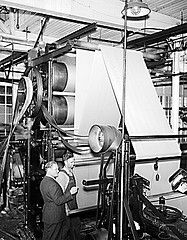Manufacturing
See also: Manufacturing (From NC Atlas Revisited); Manufacturing Table of Contents; Manufacturing Overview; Exports; Furniture; Information Technology; Iron and Steel Industry; Textiles; Tobacco; Chatham Manufacturing Company; Coleman Manufacturing Company; Fries Manufacturing and Power Company
Part i: Introduction; Part ii: Manufacturing in the Colonial and Antebellum Eras; Part iii: Decline of Iron Production and the Effects of the Civil War; Part iv: Postwar Struggles and the Growth of the Milling, Tobacco, and Textile Industries; Part v: Twentieth-Century Labor Problems, the Great Depression, and Economic Recovery; Part vi: New Industries, Increased Competition, and Diversification in the Modern Era
Part I: Introduction
Manufacturing has been a diverse and vital component of North Carolina's economy since the early nineteenth century. Initially, farming or planting was widely seen as the most profitable business opportunity, and industrial investment and interest tended to arise only during periods of agricultural depression. Early manufacturing activity was meager, the result of the state's few easily exploited deposits of minerals such as iron and coal, its modest and somewhat inconstant waterpower sources, and its lack of capital. North Carolina soon became an industrial force, however, with much of its industry centered around furniture, textiles, and tobacco. Despite troubling economic trends affecting its industries, and seemingly in contrast to the predominately rural character of many of its counties, North Carolina in the early 2000s remained one of the nation's ten most industrialized states.
Keep reading > Part II: Manufacturing in the Colonial and Antebellum Eras ![]()
References:
Brent D. Glass, The Textile Industry in North Carolina: A History (1992).
Douglass C. North, The Economic Growth of the United States, 1790-1860 (1961).
North Carolina Dept. of Commerce and Harris Publishing Co., North Carolina Manufacturers Directory (2002).
George B. Tindall, The Emergence of the New South, 1913-1945 (1967).
Image Credit:
Combed Yarn Industry, NC, 1938. The calendar rolls and irons out wrinkles etc. This happens to be a US order for army uniform cloth (George Cramer of Cramerton Mills). From Conservation and Development Department, Travel and Tourism photo files, North Carolina State Archives. Image courtesy of State Archiveso of North Carolina, call #:ConDev1821A. Available from https://www.flickr.com/photos/north-carolina-state-archives/2702204298/ (accessed October 2, 2012).
1 January 2006 | Detreville, John R.; Hall, Lisa Coston
